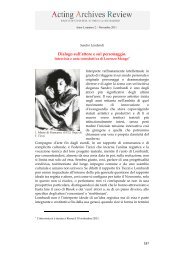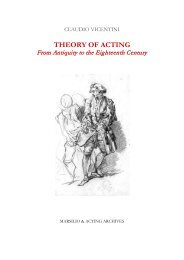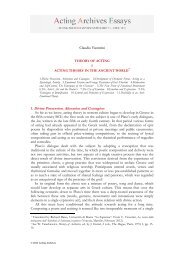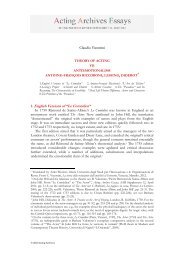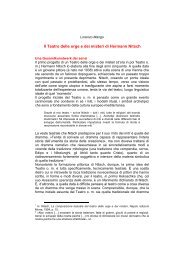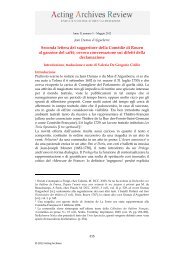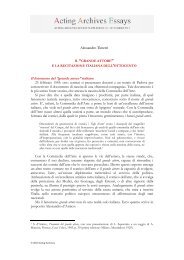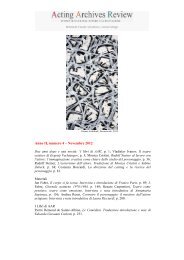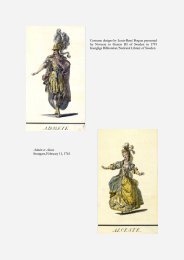Maria Ines Aliverti_The Miniatures of Jean Louis ... - Acting Archives
Maria Ines Aliverti_The Miniatures of Jean Louis ... - Acting Archives
Maria Ines Aliverti_The Miniatures of Jean Louis ... - Acting Archives
Create successful ePaper yourself
Turn your PDF publications into a flip-book with our unique Google optimized e-Paper software.
AAR <strong>Acting</strong> <strong>Archives</strong> Essays Supplement 10 – April 2011<br />
1. Whirsker and/or Faesch<br />
When Johann Ludwig Wernhard Faesch, 7 a miniaturist painter from Basle, died<br />
on 20 May 1778, not long after reaching his thirty-ninth birthday, in a modest<br />
apartment on Rue du Four in the popular Faubourg Saint-Marcel quarter, it cannot<br />
be said that he had been living a life <strong>of</strong> comfort and ease: neither his high social<br />
origins, 8 nor the commercial success <strong>of</strong> his vignettes seem to have ensured him any<br />
7 In general I have adopted the French version <strong>of</strong> his first name, <strong>Jean</strong> <strong>Louis</strong>, by which the artist became<br />
known. As a standard spelling <strong>of</strong> his surname I have used Faesch (Fäsch), and not de Faesch. <strong>The</strong><br />
surname <strong>of</strong> the family from Basel is also common with other spellings, dictated by different<br />
pronunciations or spelling systems: Fesch or de Fesch (frequently seen is the name <strong>of</strong> another, more<br />
famous member <strong>of</strong> the family: Cardinal Fesch, a relative <strong>of</strong> Napoleon’s mother and a great collector),<br />
Fasch, Fache, Foesch, Foech, Foëch, Fish, Väsch etc. sometimes accompanied in French by the specification<br />
de Basle. Here (and in the subsequent note) are listed the biographical reference works I have<br />
consulted: ‘Faesch, Johann Ludwig’, in Hans Rudolf Füssli, Allgemeines Künstlerlexicon, 2 vols., Zürich,<br />
Orell, Füssli und Compagnie, 1779-1806, II (1806), pp. 338-339: this is the earliest reference work to<br />
mention Faesch; ‘Fäsch, Johann Ludwig’, in Ernst Lembergerer, Meisterminiaturen aus Fünf Jahrhunderten,<br />
Stuttgart, Deutsche Verlags-Anstalt, 1911, p. 34: Faesch is recorded as a painter <strong>of</strong> miniatures on ivory<br />
and watercolour miniatures on vellum; ‘Fäsch, Johann Ludwig’, in Carl Brun Schweizerisches Künstler-<br />
Lexicon, 4 vols., Frauenfeld, Huber, 1905-1917, II (1905), p. 436: the author only mentions the success<br />
<strong>of</strong> Faesch’s miniatures in London and in Paris. Both Lemberger and Brun give a wrong date for<br />
Faesch’s birth: Basel c.1750; ‘Fesch’, in J. J. Foster, A Dictionary <strong>of</strong> Painters <strong>of</strong> <strong>Miniatures</strong> (1525-1850):<br />
With Some Account <strong>of</strong> Exhibitions, Collections, Sales etc., Pertaining to <strong>The</strong>m, ed. by Ethel M. Foster, London,<br />
Philip Allan, 1926, p. 110; ‘Faesch, Johann Ludwig Wernhard’, in Leo R. Schidl<strong>of</strong>, La miniature en<br />
Europe aux 16ème, 17ème, 18ème et 19ème siècles, 4 vols., Graz, Akademische Druck- und Verlagsanstalt,<br />
1964, I, p. 254; ‘Faesch, Johann Ludwig Wernhard’, in Daphne Foskett, A Dictionary <strong>of</strong> British Miniature<br />
Painters, 2 vols., London, Faber and Faber, 1972, I, p. 266; ‘Faesch, Johann Ludwig Wernhard’, in<br />
Harry Blättel, International Dictionary: Miniature Painters, Porcelain Painters Silhouettists, München, Arts and<br />
Antiques Ed. Munich, 1992, pp. 338-339: Faesch is recorded as a painter <strong>of</strong> miniatures on ivory,<br />
medallions, watercolour miniatures on vellum; Emmanuel Bénézit, Dictionnaire critique et documentaire des<br />
peintres, sculpteurs, dessinateurs et graveurs de tous les temps et de tous les pays, ed. by Jacques Busse, 14 vols.,<br />
Paris, Gründ, 1999, V, p. 255, listing the artist under Fache, concisely writes: ‘Actif à Paris à la fin du<br />
XVIIIe siècle. Français. Peintre miniaturiste’; Renate Treydel, ‘Faesch, Johann Ludwig Wernhard’, in<br />
Allgemeines Künstler-Lexicon, München-Leipzig, Saur, XXXVI (2003), p. 192.<br />
8 <strong>The</strong> Faesch belonged to the old bourgeoisie <strong>of</strong> Basel. Settled there at the beginning <strong>of</strong> the fifteenth<br />
century, they plied their trade as gold- and silversmiths over the course <strong>of</strong> many generations. See C.<br />
Brun, Schweizerisches Künstler-Lexicon, IV, Supplement: A-Z (1917), pp. 141-143. However, various<br />
members <strong>of</strong> the family distinguished themselves both in other artistic pr<strong>of</strong>essions as master builders,<br />
civil and military engineers and architects, and in the liberal pr<strong>of</strong>essions, in particular as jurists, or in<br />
the scientific or military fields. In the seventeenth century one member <strong>of</strong> the family, Remigius<br />
(Romey, Ruman) Faesch (1595-1667), created a famous collection <strong>of</strong> antiquities and rarities, whose<br />
direction was traditionally entrusted to a man <strong>of</strong> the law from the family (see Das Museum Faesch: Ein<br />
Basler Kunst- und Raritätensammlung aus dem 17. Jahrhundert, ed. by Remigius Sebastian Faesch and André<br />
Salvisberg, Basel, C. Merian, 2005). On the family and its prominent members see ‘Faesch, famille de<br />
Bâle’, in Biographie universelle ancienne et moderne, ed. by <strong>Louis</strong> Gabriel Michaud and others, 45 vols., Paris,<br />
Madame C. DesplacesM. Michaud; Leipzig, F. A. Brockhaus, 1854-1865, XIII (1855), pp. 320-321;<br />
‘Faesch’ in Dictionnaire Historique et Biographique de la Suisse, ed. by Victor Attinger and others, 8 vols.,<br />
Neuchâtel, Administration du dictionnaire historique et biographique de la Suisse, 1921-1934, III<br />
(1926), pp. 48-49. On members <strong>of</strong> the family who were craftsmen, artists or architects, see Allgemeines<br />
Künstler-Lexicon, XXXVI, pp. 191-195. No indication is given about Johann Ludwig’s direct relatives.<br />
<strong>The</strong> document quoted below states that Johann Ludwig’s brother was ‘Georges Faesch’, in 1778<br />
captain in the service <strong>of</strong> H. M. the King George III. I cannot positively affirm if this ‘Georges’ is the<br />
same person as the Georg Rudolph Faesch (1712-1787) who translated various works <strong>of</strong> military art;<br />
from French into German: Grundsätze und Regeln der Kriegs-Kunst by the Marquis de Puységur, Leipzig,<br />
1753; Einfälle über die Kriegskunst by the Count Maurice <strong>of</strong> Saxony, Leipzig and Frankfurt, 1757. And<br />
from German into French: Instruction militaire du roi de Prusse pour ses généraux, traduite de l’allemand par M.<br />
4



